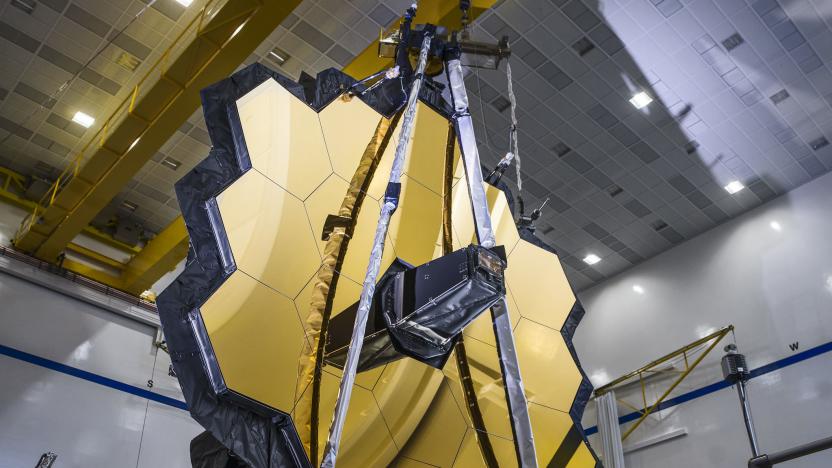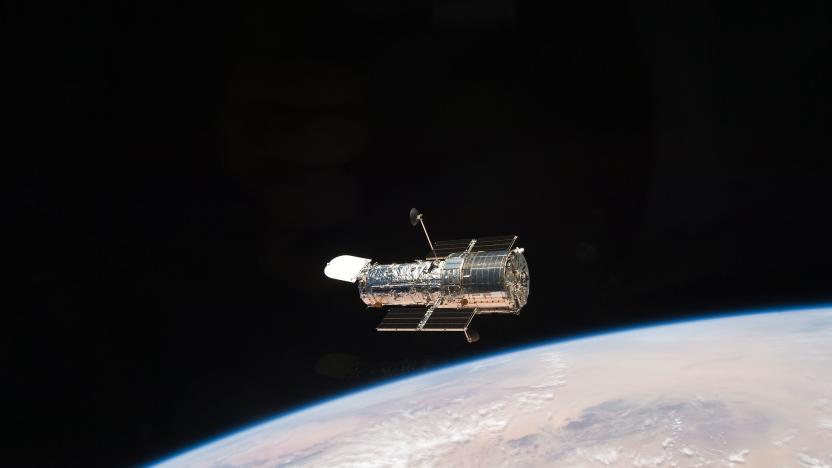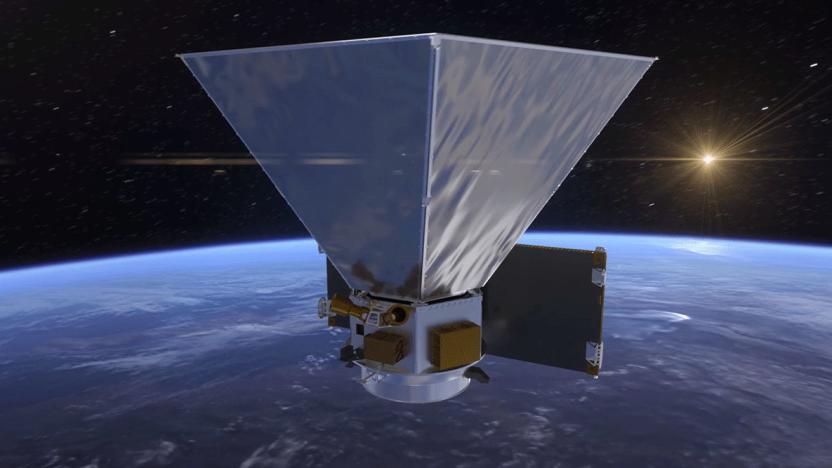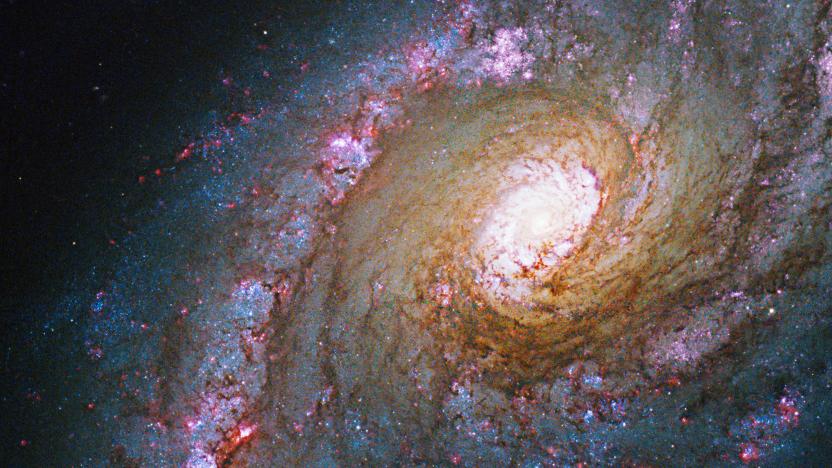space telescope
Latest

James Webb telescope captures the most distant active supermassive black hole yet
As part of the Cosmic Evolution Early Release Science (CEERS) Survey, researchers have discovered the most distant active supermassive black hole we've seen to date.

James Webb telescope can take detailed photos of our own solar system's planets and moons
NASA has released images of Jupiter taken during James Webb's commissioning period.

President Biden will reveal the first James Webb Space Telescope image today at 5PM ET
NASA has decided to reveal the first James Webb Space Telescope (JWST) image today rather than waiting until tomorrow as planned.

The Hubble telescope is fully operational again after a month-long nap
After multiple instrument sync failures that required putting Hubble into safe mode, NASA says the telescope is now functioning as normal, with all four active instruments collecting data.

NASA's TESS spacecraft has already found 2,200 possible planets
NASA's TESS spacecraft has already found 2,200 potential planets, surpassing its original goal and raising hope of finding Earth-like worlds.

NASA reveals how its SPHEREx space telescope will search for big bang clues
NASA has hit a key milestone in the development of SPHEREx space telescope, designed for the lofty purpose of studying the Big Bang theory and origins of galaxies.

30 years on, Hubble is still making dazzling discoveries
NASA announced that Hubble has released 30 newly created Hubble images as part of the Caldwell catalog.

Earth's orbiting observatories and their literally awesome images
While the Voyager 1 probe, launched in 1977, cruises into interstellar space (the farthest man-made object from Earth) and missions like New Horizons capture snaps from the outskirts of the solar system, we've been keeping the heavy hitters close to home. Massive space telescopes that scan the cosmos with augmented eyes have been orbiting the Earth for years to get a clear view of the universe without atmospheric distortion. The Hubble Space Telescope's 1990 launch set a new precedent for these space-based observatories in terms of scale and abilities. These new instruments have helped scientists gather an incredible amount of data and mind-bending photos from deep space. With Pluto hogging the spotlight lately, we decided to take a look back at some of these powerful orbiting eyes and their visual achievements. [Image credit: JPL]

The Big Picture: NuSTAR telescope shows the sun blasting out X-rays
Pop quiz, hotshot: What do you get when you heat gas above 3 million degrees Celsius? High-energy X-rays, of course -- just the kind that NuSTAR was launched to detect. The space telescope took a break from hunting black holes to snap its first-ever shot of the sun. When that X-ray image (blue and green) is overlaid onto an infrared photo from the Solar Dynamics Observatory (in orange), it shows how X-rays relate to high-temperature solar activity like flares and sunspots. Scientists want to figure out why the sun's corona (outer atmosphere) is 1 million degrees Celsius, while the surface is a mere 6,000 degrees Celsius -- a discrepancy that's like a "flame coming out of an ice cube," according to NASA. Though it might sound risky to point the world's most sensitive high-energy X-ray telescope at the sun, it's actually quite safe -- our star emits plenty of X-rays, but very few of the high-energy type. [Image credit: NASA/JPL]

Astronomers accidentally discovered the brightest pulsar on record
Remember NuSTAR, the specialized space telescope NASA designed specifically to study black holes? It just found something much, much brighter. Astronomers at NASA have stumbled upon what appears to be the most luminous pulsar ever discovered, but they almost mistook it for a black hole. After measuring the dead star's output, they found it was outputting as much energy as 10 million suns -- shockingly powerful, considering how much smaller it is than our own star. Astronomers aren't sure why the pulsar is so bright, but will continue to study in hopes of learning how common or uncommon this kind of pulsar is. The discovery kind of shakes up what theorist knew about black holes and ultraluminous x-rays, underlining how little we really know about the universe out there. Check out NASA's gallery of images at the source link below.

Crowd-funded group building asteroid-mapping telescope, saving Earth (video)
Just when you're numbing to robot, zombie and nuclear apocalypse scenarios, some old-fashioned asteroid paranoia pops up to surprise you. The B612 Foundation, which gets funding from, well, anyone, has just announced plans to launch Sentinel, a space telescope which will wander the vacuum cataloging asteroids in our inner solar system. Their goal is to track asteroid orbits and predict large impacts up to 100 years in advance, giving us plenty of time to find a solution (or enjoy our final days). Construction doesn't start til late fall, with the launch expected in around five years, so it won't be any use in disproving the 2012 doomsday believers out there. You can find out more about the project and donate to the foundation at the source link, or jump past the break for a video explanation, Aerosmith not included.

NASA's black hole-hunting NuSTAR mission launched today
The black hole-hunting telescope NASA announced last month launched from Kwajalein Atoll in the central Pacific Ocean today. The $165 million NuSTAR mission will spend two years scouring the universe for black holes by scanning X-ray light at higher energies than its predecessors. According to Space.com, NuSTAR will especially target high-energy regions of the universe where "matter is falling onto black holes, as well as the leftovers from dead stars after they've exploded in supernovas." Head on past the break for a video of the launch and click through to the source link for more details and images.

NASA preps black hole-hunting space telescope for launch next month
Scientists will soon have a new tool at their disposal in their search for black holes and a greater understanding of what NASA describes as "the most energetic and exotic objects in space." The space agency announced today that it has begun preparing its Nuclear Spectroscopic Telescope Array -- otherwise known as NuSTAR -- for launch from Kwajalein Atoll in the central Pacific Ocean, with a liftoff planned for no earlier than June 13th. The telescope is by far the most advanced of its type to date, boasting ten times the resolution and more than 100 times the sensitivity of its predecessors, as well as a new design that relies on a complex set of 133 ultra-thin nested mirrors -- a setup NASA compares to a Russian Doll. Those interested can get a brief overview of the mission in the video after the break








